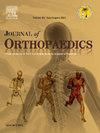Dynamic patterns of varus deformity among osteoarthritic knees during computer-navigation assisted total knee arthroplasty and their surgical implications
IF 1.5
Q3 ORTHOPEDICS
引用次数: 0
Abstract
Aims
The aims of this study were to (a) identify the dynamic patterns of varus deformity among osteoarthritic knees, (b) describe their surgical implications, and (c) compare post-operative lower limb alignment, clinical outcomes and satisfaction among patients with different deformity patterns managed intra-operatively based on deductions drawn from the same.
Methods
Patients with primary osteoarthritis of the knee with an intra-articular varus deformity, undergoing computer-navigation assisted total knee arthroplasty using a sub-vastus approach and the “femur-first” measured resection technique between October 2019 and June 2020 were recruited. Following surgical exposure, the coronal knee deformity was assessed during full extension and 15°, 30°, 45°, 60°, 75°, and 90° of flexion. The levels of bony and/or soft-tissue pathology were identified based on the deformity pattern noted. Mechanical bone resection and indicated soft-tissue releases were performed. Post-operative alignment and outcomes were compared among knees with different deformity patterns.
Results
In all, 127 patients (59.1 % women) with a mean age of 62.4 years were available for follow-up. The mean duration of follow-up was 24.7 months. Five patterns of varus deformity emerged, each indicating different levels of pathology: (i) pattern-1: the deformity increased on flexion, (ii) pattern-2: the deformity decreased on flexion, (iii) pattern-3: the deformity remained constant throughout flexion, (iv) pattern-4: the deformity increased initially, then decreased on flexion, and (v) pattern-5: the deformity decreased initially, then increased on flexion. Individualized soft-tissue release helped restore alignment within 3° of the mechanical axis in all knees. At the two years’ follow-up, the clinical outcomes and patient satisfaction were comparable among patients with all deformity patterns.
Conclusions
Knees with primary varus osteoarthritis demonstrate simple dynamic patterns of coronal deformity. An understanding of these patterns permits identification of the levels of pathology and helps in their optimal management, resulting in uniformly satisfactory outcomes.
求助全文
约1分钟内获得全文
求助全文
来源期刊

Journal of orthopaedics
ORTHOPEDICS-
CiteScore
3.50
自引率
6.70%
发文量
202
审稿时长
56 days
期刊介绍:
Journal of Orthopaedics aims to be a leading journal in orthopaedics and contribute towards the improvement of quality of orthopedic health care. The journal publishes original research work and review articles related to different aspects of orthopaedics including Arthroplasty, Arthroscopy, Sports Medicine, Trauma, Spine and Spinal deformities, Pediatric orthopaedics, limb reconstruction procedures, hand surgery, and orthopaedic oncology. It also publishes articles on continuing education, health-related information, case reports and letters to the editor. It is requested to note that the journal has an international readership and all submissions should be aimed at specifying something about the setting in which the work was conducted. Authors must also provide any specific reasons for the research and also provide an elaborate description of the results.
 求助内容:
求助内容: 应助结果提醒方式:
应助结果提醒方式:


